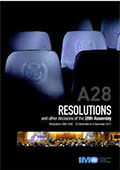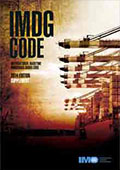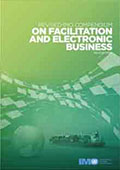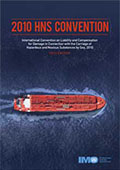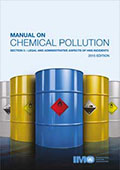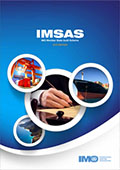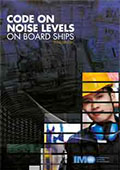
Sempre foi reconhecido que a melhor forma de melhorar a segurança no mar é através do desenvolvimento de normas internacionais que são seguidas por todas as nações marítimas e a partir de meados do século 19 em diante, foram adotadas uma série de tratados sobre o assunto. Vários países propuseram que um organismo internacional permanente deveria ser estabelecido para promover a segurança marítima de forma mais eficaz
Em 1948, uma conferência internacional em Genebra, aprovou uma convenção estabelecendo formalmente IMO (o nome original da Organização Marítima Consultiva Intergovernamental, ou IMCO, mas o nome foi mudado em 1982 para IMO). A Convenção IMO entrou em vigor em 1958 e a Organização nova reuniu-se pela primeira vez no ano seguinte. Os objetivos da Organização, conforme resumido pelo artigo 1º da Convenção, são "para fornecer mecanismos de cooperação entre os Governos no campo da regulamentação governamental e práticas relacionadas com assuntos técnicos de todos os tipos que interessem à navegação comercial internacional, para incentivar e facilitar a adoção geral dos mais elevados padrões possíveis em matéria de segurança marítima, à eficiência da navegação e prevenção e controle da poluição marinha causada por navios ". A Organização também está habilitada a tratar de assuntos administrativos e jurídicos relacionados com esses fins.
| Publication date 2013 | |
The 28th session of the IMO Assembly took place at the Headquarters of the Organization from 25 to 4 December 2013. This publication contains, amongst others, resolutions pertaining to: |
| Publication date 2014 | |
The International Maritime Dangerous Goods Code relates to the safe carriage of dangerous goods by sea, but does not include all details of procedures for packing of dangerous goods or actions to take in the event of an emergency or accident involving personnel who handle goods at sea. These aspects are covered by the publications that are associated with the IMDG Code, which are included in this Supplement. |
| Publication date 2014 | |
This edition of the Revised IMO Compendium on Facilitation and Electronic Business was adopted at the thirty-eighth session of the FAL Committee and supersedes the 2001 edition. This edition contains the UN/EDIFACT codes for the FAL Forms established in the FAL Convention as well as for reporting security-related information prior to the entry of a ship into port. |
| Publication date 2013 | |
Part 1 contains: |
| Publication date 2015 | |
The manual aims to provide the reader, in particular on-scene commanders, response personnel, government entities and others involved in the management and/or response to pollution incidents involving Hazardous and Noxious Substance (HNS), with a description of the various interests involved in an HNS incident and its aftermath. |
| Publication date 2015 | |
This publication contains all relevant resolutions adopted by the International Maritime Organization (IMO) in the process of the institutionalization of the IMO Member State Audit Scheme (IMSAS), as well as other documents developed to support its effective implementation. It includes: |
| Publication date 2014 | |
The Code on noise levels on board ships has been developed to provide international standards for protection against noise under the provisions of regulation II-1/3-12 of the SOLAS Convention. The Code, adopted by resolution MSC.337(91), recognizes the need to establish mandatory noise level limits for machinery spaces, control rooms, workshops, accommodation and other spaces on board ships, and enters into force on 1 July 2014. |
